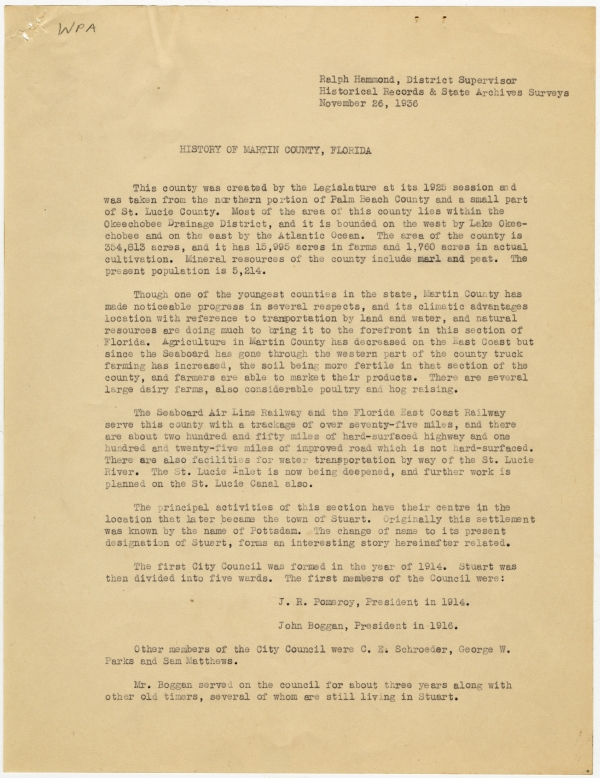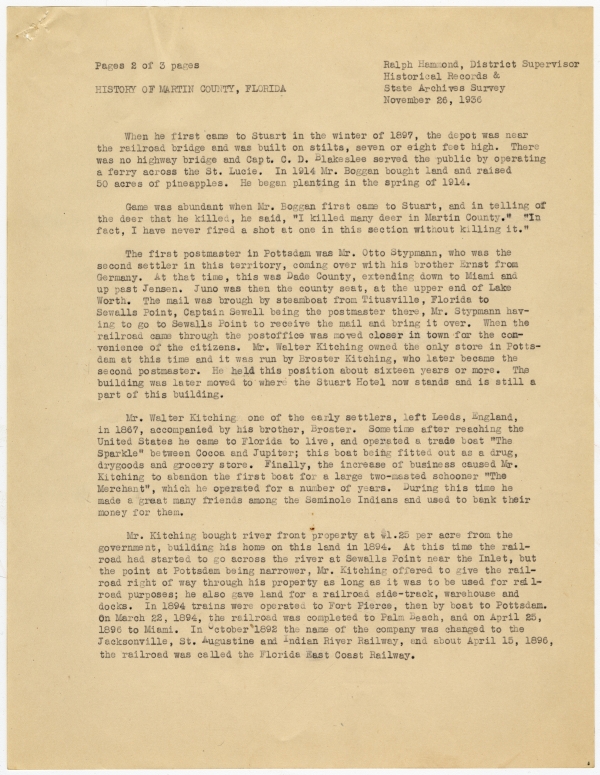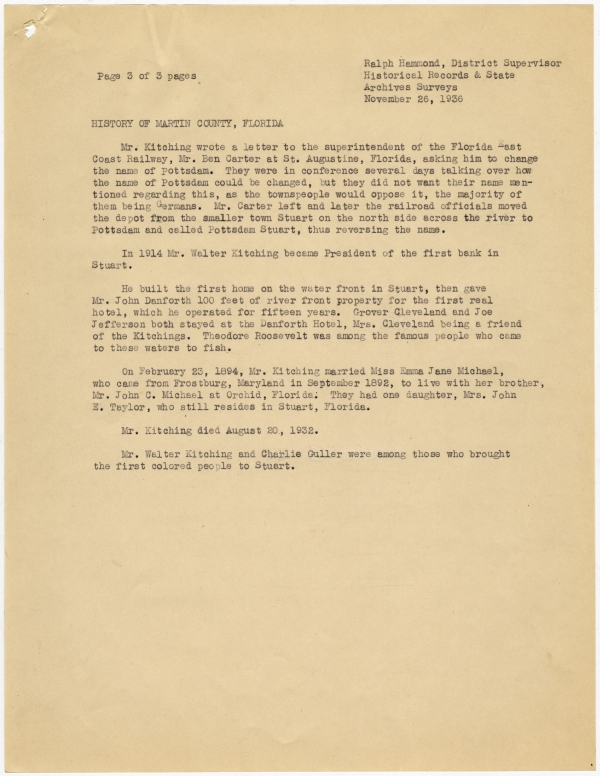WPA
Ralph Hammond, District Supervisor
Historical Records & State Archives Surveys
November 26, 1936
HISTORY OF MARTIN COUNTY, FLORIDA
This county was created by the Legislature at its 1925 session and was taken from the northern portion of Palm Beach County and a small part of St. Lucie County. Most of the area of this county lies within the Okeechobee Drainage District, and it is bounded on the west by Lake Okeechobee and on the east by the Atlantic Ocean. The area of the county is 354,813 acres, and it has 15,995 acres in farms and 1,760 acres in actual cultivation. Mineral resources of the county include marl and peat. The present population is 5,214.
Though one of the youngest counties in the state, Martin County has made noticeable progress in several respects, and its climatic advantages location with reference to transportation by land and water, and natural resources are doing much to bring it to the forefront in this section of Florida. Agriculture in Martin County has decreased on the East Coast but since the Seaboard has gone through the western part of the county truck farming has increased, the soil being more fertile in that section of the county, and farmers are able to market their products. There are several large dairy farms, also considerable poultry and hog raising.
The Seaboard Air Line Railway and the Florida East Coast Railway serve this county with a trackage of over seventy-five miles, and there are about two hundred and fifty miles of hard-surfaced highway and one hundred and twenty-five miles of improved road which is not hard-surfaced. There are also facilities for water transportation by way of the St. Lucie River. The St. Lucie Inlet is now being deepened, and further work is planned on the St. Lucie Canal also.
The principal activities of this section have their centre in the location that later became the town of Stuart. Originally this settlement was known by the name Pottsdam. The change of name to its present designation of Stuart, forms an interesting story hereinafter related.
The first City Council was formed in the year of 1914. Stuart was then divided into five wards. The first members of the Council were:
J. R. Pomeroy, President in 1914.
John Boggan, President in 1916.
Other members of the City Council were C. E. Schroeder, George W. Parks and Sam Matthews.
Mr. Boggan served on the council for about three years along with other old timers, several of whom are still living in Stuart.
Pages 2 of 3 pages
HISTORY OF MARTIN COUNTY, FLORIDA
Ralph Hammond, District Supervisor
Historical Records &
State Archives Surveys
November 26, 1936
When he first came to Stuart in the winter of 1897, the depot was near the railroad bridge and was built on stilts, seven or eight feet high. There was no highway bridge and Capt. C. D. Blakeslee served the public by operating a ferry across the St. Lucie. In 1914 Mr. Boggan bought land and raised 50 acres of pineapples. He began planting in the spring of 1914.
Game was abundant when Mr. Boggan first came to Stuart, and in telling of the deer that he killed, he said, "I killed many deer in Martin County." "In fact, I have never fired a shot at one in this section without killing it."
The first postmaster in Pottsdam was Mr. Otto Stypmann, who was the second settler in this territory, coming over with his brother Ernst from Germany. At that time, this was Dade County, extending down to Miami and up past Jensen. Juno was then the county seat, at the upper end of Lake Worth. The mail was [brought] by steamboat from Titusville, Florida to Sewalls Point, Captain Sewall being the postmaster there, Mr. Stypmann having to go to Sewalls Point to receive the mail and bring it over. When the railroad came through the postoffice was moved closer in town for the convenience of the citizens. Mr. Walter Kitching owned the only store in Pottsdam at this time and it was run by Broster Kitching, who later became the second postmaster. He held this position about sixteen years or more. The building was later moved to where the Stuart Hotel now stands and is still a part of this building.
Mr. Walter Kitching one of the early settlers, left Leeds, England, in 1867, accompanied by his brother, Broster. Sometime after reaching the United States he came to Florida to live, and operated a trade boat "The Sparkle" between Cocoa and Jupiter; this boat being fitted out as a drug, drygoods and grocery store. Finally, the increase of business caused Mr. Kitching to abandon the first boat for a large two-masted schooner "The Merchant", which he operated for a number of years. During this time he made a great many friends among the Seminole Indians and used to bank their money for them.
Mr. Kitching bought river front property at $1.25 per acre from the government, building his home on this land in 1894. At this time the railroad had started to go across the river at Sewalls Point near the Inlet, but the point at Pottsdam being narrower, Mr. Kitching offered to give the railroad right of way through his property as long as it was to be used for railroad purposes; he also gave land for a railroad side-track, warehouse and docks. In 1894 trains were operated to Fort Pierce, then by boat to Pottsdam. On March 22, 1894, the railroad was completed to Palm Beach, and on April 25, 1896 to Miami. In October 1892 the name of the company was changed to the Jacksonville, St. Augustine and Indian River Railway, and about April 15, 1896, the railroad was called the Florida East Coast Railway.
Page 3 of 3 pages
Ralph Hammond, District Supervisor
Historical Records & State
Archives Surveys
November 26, 1936
HISTORY OF MARTIN COUNTY, FLORIDA
Mr. Kitching wrote a letter to the superintendent of the Florida East Coast Railway, Mr. Ben Carter at St. Augustine, Florida, asking him to change the name of Pottsdam. They were in conference several days talking over how the name of Pottsdam could be changed, but they did not want their name mentioned regarding this, as the townspeople would oppose it, the majority of them being Germans. Mr. Carter left and later the railroad officials moved the depot from the smaller town Stuart on the north side across the river to Pottsdam and called Pottsdam Stuart, thus reversing the name
In 1914 Mr. Walter Kitching became President of the first bank in Stuart.
He built the first home on the water front in Stuart, then gave Mr. John Danforth 100 feet of river front property for the first real hotel, which he operated for fifteen years. Grover Cleveland and Joe Jefferson both stayed at the Danforth Hotel, Mrs. Cleveland being a friend of the Kitchings. Theodore Roosevelt was among the famous people who came to these waters to fish.
On February 23, 1894, Mr. Kitching married Miss Emma Jane Michael, who came from Frostburg, Maryland in September 1892, to live with her brother, Mr. John C. Michael at Orchid, Florida. They had one daughter, Mrs. John E. Taylor, who still resides in Stuart, Florida.
Mr. Kitching died August 20, 1932.
Mr. Walter Kitching and Charlie Guller were among those who brought the first colored people to Stuart.




 Listen: The FolkFolk Program
Listen: The FolkFolk Program
